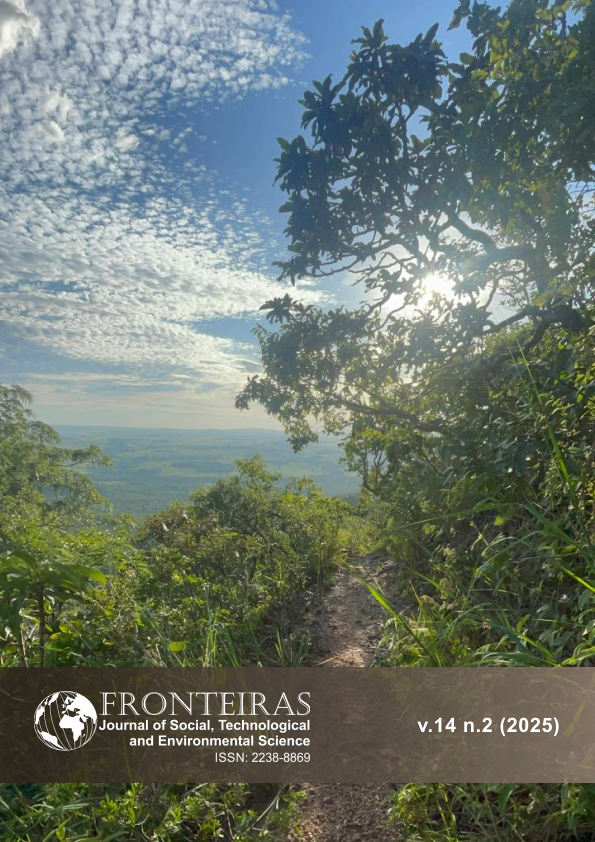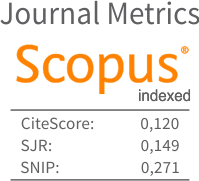Arbuscular Mycorrhizal Fungi in Cerrado: An Overview of Scientific Production, Trends, and Gaps
DOI:
https://doi.org/10.21664/2238-8869.2025v14i2.p31-44Palabras clave:
AMF, Cerrado, Glomeromycota, scientometricsResumen
Arbuscular mycorrhizal fungi (AMF) are obligate biotrophic fungi from the Glomeromycota phylum, closely related to plant biomass. However, little is known about these fungi since they live below ground, especially in threatened and important areas like the Cerrado. Our aim in this study was to evaluate the trends and gaps in the scientific production of Glomeromycota in the Cerrado, to show an overview of scientific production over the last ten years, showing trends and gaps in research on AMF in the Cerrado. We used a Boolean search for articles in the Web of Science database with specific terms to do this. We obtained 63 articles which showed us that there is a trend towards an increase in the number of publications on AMF, however, most of the studies are focused on an ecological, taxonomic, and agricultural approach to the fungus, leaving a large gap in biotechnological knowledge and the use of these fungi. We hope that these data will help with research into AMF and boost knowledge about the Glomeromycota phylum in the Cerrado.
Citas
Abrahão, A, Costa, PB, Lambers, H, Andrade, SAL, Sawaya, ACHF, Ryan, MH, Oliveira, RS 2019. Soil types select for plants with matching nutrient-acquisition and -use traits in hyperdiverse and severely nutrient-impoverished campos rupestres and cerrado in Central Brazil. Journal of Ecology, 107(3), 1302-1316. DOI: https://doi.org/10.1111/1365-2745.13111
Aker, AM, Caproni, AL, Berbara, RLL, Granha, JRDDO, Silva, CFD, Pereira, MG 2022. Arbuscular mycorrhizal fungi in the Cerrado biome: effects of land use system, soil texture, and seasonality. Revista Caatinga, 35, 170-180. DOI: https://doi.org/10.1590/1983-21252022v35n117rc
Araujo, ASF, Melo, VMM, Pereira, APA, Lopes, ÂCA 2021. Arbuscular mycorrhizal community in soil from different Brazilian Cerrado physiognomies. Rhizosphere, 19, 100375. DOI: https://doi.org/10.1016/j.rhisph.2021.100375
Aria, M, Cuccurullo, C 2017. bibliometrix: An R-tool for comprehensive science mapping analysis. Journal of Informetrics, 11(4), 959-975. DOI: https://doi.org/10.1016/j.joi.2017.08.007
Barbosa, BB, Pimentel, JP, Rodovalho, NS, Bertini, SCB, Kumar, A, Ferreira, L FR, Azevedo, LCB 2022. Ascomycetous isolates promote soil biological and nutritional attributes in corn and soybeans in sandy and clayey soils. Rhizosphere, 24, 100625. DOI: https://doi.org/10.1016/j.rhisph.2022.100625
Calaça, FJS, Bustamante, MMC 2022. Richness of arbuscular mycorrhizal fungi (Glomeromycota) along a vegetation gradient of Brazilian Cerrado: Responses to seasonality, soil types, and plant communities. Mycological Progress, 21(2), 27. DOI: https://doi.org/10.1007/s11557-022-01785-1
Carneiro, MAC, Assis, PCR, Paulino, HB, Rocha, MR 2019. Diversity of arbuscular mycorrhizal fungi and nematodes in a 14 years no-tillage chronosequence. Rhizosphere, 10, 100149. DOI: https://doi.org/10.1016/j.rhisph.2019.100149
Carvalho, F, Souza, FA, Carrenho, R, Moreira, FMS, Jesus, EC, Fernandes, GW 2012. The mosaic of habitats in the high-altitude Brazilian rupestrian fields is a hotspot for arbuscular mycorrhizal fungi. Applied Soil Ecology, 52, 9-19. DOI: https://doi.org/10.1016/j.apsoil.2011.10.001
Carvalho, FMV, Marco, P, Ferreira, LG 2009. The Cerrado into-pieces: Habitat fragmentation as a function of landscape use in the savannas of central Brazil. Biological Conservation, 142(7), 1392-1403. DOI: https://doi.org/10.1016/j.biocon.2009.01.031
Castro, AP, Silva, MRSS, Quirino, BF, Bustamante, MMC, Krüger, RH 2016. Microbial Diversity in Cerrado Biome (Neotropical Savanna) Soils. PLOS ONE, 11(2), e0148785. DOI: https://doi.org/10.1371/journal.pone.0148785
Cely, MVT, Oliveira, AG, Freitas, VF, Luca, MB, Barazetti, AR, Santos, IMO, Gionco, B, Garcia, GV, Prete, CEC, Andrade, G 2016. Inoculant of Arbuscular Mycorrhizal Fungi (Rhizophagus clarus) Increase Yield of Soybean and Cotton under Field Conditions. Frontiers in Microbiology, 7. DOI: https://www.frontiersin.org/articles/10.3389/fmicb.2016.00720
Moura, JB, Souza, RF, Junior, WGV, Lima, IR, Brito, GHM, Marín, C 2019. Arbuscular Mycorrhizal Fungi Associated with Bamboo Under Cerrado Brazilian Vegetation. Journal of Soil Science and Plant Nutrition, 19(4), 954-962. DOI: https://doi.org/10.1007/s42729-019-00093-0
Detmann, K, Souza LT, Oliveira Neto RR, Delgado, MN, Rebello, VPA, Azevedo, AA, Kasuya, MCM, Selosse, MA, Almeida, AM 2019. Arbuscular mycorrhizae and absence of cluster roots in the Brazilian Proteaceae Roupala montana Aubl. Symbiosis, 77(2), 115-122. DOI: https://doi.org/10.1007/s13199-018-0581-0
French, KE 2017. Engineering Mycorrhizal Symbioses to Alter Plant Metabolism and Improve Crop Health. Frontiers in Microbiology, 8, 1403. DOI: https://doi.org/10.3389/fmicb.2017.01403
Gerz, M, Bueno, CG, Ozinga, WA, Zobel, M, Moora, M 2019. Responses of plant community mycorrhization to anthropogenic influence depend on the habitat and mycorrhizal type. Oikos, 128(11), 1565-1575. DOI: https://doi.org/10.1111/oik.06272
Guilherme, FAG, Júnior, AF, Souza, LF, Martins, AP, Ferreira, GL, Maciel, EA 2022. Effect of drainage ditches on diversity, structure and dynamics vegetation in campos de murundus (mound fields). Ecological Engineering, 182, 106723. DOI: https://doi.org/10.1016/j.ecoleng.2022.106723
Hammer, O, Harper, D, Ryan, P 2001. PAST: Paleontological Statistics Software Package for Education and Data Analysis. Palaeontologia Electronica, 4, 1-9.
Hart, MM, Antunes, PM, Chaudhary, VB, Abbott, LK 2018. Fungal inoculants in the field: Is the reward greater than the risk? Functional Ecology, 32(1), 126-135. DOI: https://doi.org/10.1111/1365-2435.12976
Jesus, MV, Scalon, SPQ, Dresch, DM, Linné, JA, Lima, VT, Reis, LC, Santos, CC, Foresti, AC 2022. Arbuscular mycorrhizae alleviate water deficit in Dipteryx alata Vogel: Seedling quality and resilience. Canadian Journal of Forest Research, 52(3), 320-327. DOI: https://doi.org/10.1139/cjfr-2021-0088
Jobim, K, Oliveira, BIS, Goto, BT 2016. Checklist of the Glomeromycota in the Brazilian Savanna. Glomeromycota in the Brazilian Savanna, 131, 13.
Leite, M, Cassiolato, AMR, Lannes, LS 2019. Urochloa decumbens Has Higher Mycorrhizal Colonization in Degraded than in Pristine Areas in the Brazilian Cerrado. Floresta e Ambiente, 26, e20190060. DOI: https://doi.org/10.1590/2179-8087.006019
Lima, DC, Alves, MR, Noguera, NH, Nascimento, RP 2022. A review on Brazilian baru plant (Dipteryx alata Vogel): Morphology, chemical composition, health effects, and technological potential. Future Foods, 5, 100146. DOI: https://doi.org/10.1016/j.fufo.2022.100146
Lucas, LS, Neto, AR, Moura, JB, Souza, RF, Santos, MEF, Moura, LF, Xavier, EG, Santos, JM, Nehring, R, Dutra e Silva, S 2022. Mycorrhizal fungi arbuscular in forage grasses cultivated in Cerrado soil. Scientific Reports, 12(1), Artigo 1. DOI: https://doi.org/10.1038/s41598-022-07088-5
Magalhães, RM 2014. A cadeia produtiva da amêndoa do Baru (Dipteryx alata Vog.) no Cerrado: Uma análise da sustentabilidade da sua exploração. Ciência Florestal, 24, 665-676. DOI: https://doi.org/10.5902/1980509815723
Martínez-García, LB 2011. Micorrizas arbusculares en ecosistemas semiáridos. Respuesta a factores de estrés ambiental: Ecosistemas, 20(2-3), Artigo 2-3. https://www.revistaecosistemas.net/index.php/ecosistemas/article/view/654
Moraes, JMAS, Zanchi, CS, Pires, GC, Moretti, CF, Barbosa, MV, Silva, AO, Pacheco, LP, Carbone CMA, Oliveira, RL, Kemmelmeier, K, Souza, ED 2019. Arbuscular mycorrhizal fungi in integrated crop livestock systems with intercropping in the pasture phase in the Cerrado. Rhizosphere, 11, 100165. DOI: https://doi.org/10.1016/j.rhisph.2019.100165
Moura, J, Souza, R, Vieira Junior, W, Lucas, L, Santos, J, Silva, S, Marín, C 2022. Effects of a megafire on the arbuscular mycorrhizal fungal community and parameters in the Brazilian Cerrado ecosystem. Forest Systems, 31. DOI: https://doi.org/10.5424/fs/2022311-18557
Paiva Neto, VB, Torrezan, MA, Silva, MAV, Padilha, DRC, Borel, JC, Zuffo-Borges, MCR 2022. Self-pollination of the orchid Cycnoches haagii from Brazilian Cerrado results in albino phenotype seedlings. Ornamental Horticulture, 28, 85-91. DOI: https://doi.org/10.1590/2447-536X.v28i1.2411
Pontes, JS, Pereira, CD, Machado, CTT, Coyne, D 2017. Diversity of arbuscular mycorrhizal fungi in the Brazilian's Cerrado and in soybean under conservation and conventional tillage. Applied Soil Ecology, 117-118, 178-189. DOI: https://doi.org/10.1016/j.apsoil.2017.04.023
R Core Team. R: The R Project for Statistical Computing, 2023. [cited 2023 Oct 10]. Available at: https://www.r-project.org/
Santos, GL, Pereira, MG, Delgado, RC, Magistrali, IC, Gomes SC, Oliveira, MMC, Larangeira, PBJ, Silva, PT 2021. Degradation of the Brazilian Cerrado: Interactions with human disturbance and environmental variables. Forest Ecology and Management, 482, 118875. DOI: https://doi.org/10.1016/j.foreco.2020.118875
Silva, SD, Barbosa, AS 2020. Paisagens e fronteiras do Cerrado: Ciência, biodiversidade e expansão agrícola nos chapadões centrais do Brasil. Estudos Ibero-Americanos, 46(1), e34028-e34028. DOI: https://doi.org/10.15448/1980-864X.2020.1.34028
Silva, PST, Cassiolato, AMR, Galindo, FS, Jalal, A, Nogueira, TAR, Oliveira, CES, Filho, MCMT 2022a. Azospirillum brasilense and Zinc Rates Effect on Fungal Root Colonization and Yield of Wheat-Maize in Tropical Savannah Conditions. Plants (Basel, Switzerland), 11(22), 3154. DOI: https://doi.org/10.3390/plants11223154
Silva, PST, Prates, AR, Fernandes, DM, Cassiolato, AMR, Maltoni, KL 2022b. Microrganismos e lodo de esgoto compostado no desenvolvimento inicial de mudas de baru em vasos. Engenharia Sanitaria e Ambiental, 27, 1021-1029. DOI: https://doi.org/10.1590/S1413-415220210240
Silva-Flores, P, Argüelles-Moyao, A, Aguilar-Paredes, A, Calaça, FJS, Duchicela, J, Fernández, N, Furtado, ANM, Guerra-Sierra, B, Lovera, M, Marín, C, Neves, MA, Pezzani, F, Rinaldi, AC, Rojas, K, Vasco-Palacios, AM 2021. Mycorrhizal science outreach: Scope of action and available resources in the face of global change. Plants, People, Planet, 3(5), 506-522. DOI: https://doi.org/10.1002/ppp3.10213
Souza, ED, Silva, CRM, Pinto, FA, Carneiro, MAC, Paulino, HB, Pacheco, LP, Terra, FD, Laroca, JVS 2019. Soil quality indicators after conversion of "murundu" fields into no-tillage cropping in the Brazilian Cerrado. Pesquisa Agropecuária Brasileira, 54, e00374. DOI: https://doi.org/10.1590/S1678-3921.pab2019.v54.00374
Teixeira, AFS, Kemmelmeier, K, Marascalchi, MN, Stürmer, SL, Carneiro, MAC, Moreira, FMS 2017. Arbuscular mycorrhizal fungal communities in an iron mining area and its surroundings: Inoculum potential, density, and diversity of spores related to soil properties. Ciência e Agrotecnologia, 41, 511-525. DOI: https://doi.org/10.1590/1413-70542017415014617
van der Heijden, MGA., Klironomos, JN, Ursic, M, Moutoglis, P, Streitwolf-Engel, R, Boller, T, Wiemken, A, Sanders, IR 1998. Mycorrhizal fungal diversity determines plant biodiversity, ecosystem variability and productivity. Nature, 396(6706), Artigo 6706. DOI: https://doi.org/10.1038/23932
Vieira, LC, Silva, DKA, Silva, IR, Gonçalves, CM, Assis, DMA, Oehl, F, Silva, GA 2019. Ecological aspects of arbuscular mycorrhizal fungal communities in different habitat types of a Brazilian mountainous area. Ecological Research, 34(1), 182-192. DOI: https://doi.org/10.1111/1440-1703.1061
Descargas
Publicado
Cómo citar
Número
Sección
Licencia
Derechos de autor 2025 Igor Manoel Paulo Goulart de Abreu, Isa Lucia de Morais, Francisco Júnior Simões Calaça

Esta obra está bajo una licencia internacional Creative Commons Atribución-NoComercial 4.0.
Esta revista oferece acesso livre imediato ao seu conteúdo, seguindo o princípio de que disponibilizar gratuitamente o conhecimento científico ao público proporciona maior democratização mundial do conhecimento.
A partir da publicação realizada na revista os autores possuem copyright e direitos de publicação de seus artigos sem restrições.
A Revista Fronteiras: Journal of Social, Technological and Environmental Science segue os preceitos legais da licença Creative Commons - Atribuição-NãoComercial 4.0 Internacional.


